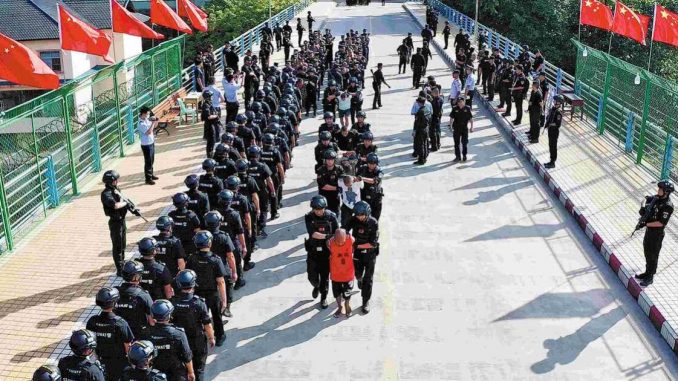
Suspects are handed over to Chinese police at the Myanmar–China border. China Daily
Published September 20, 2025
Burma (Myanmar) has been under the grip of a military junta since the 2021 coup, with widespread repression, censorship, and armed resistance defining daily life. Now, the generals in Naypyidaw have moved closer to Beijing, pledging support for China’s Global Security Initiative (GSI). This deepening partnership not only strengthens China’s regional influence but also equips the junta with powerful new tools of control. For ordinary Burmese citizens, already struggling under dictatorship, life is about to become even harder.
China’s Surveillance Blueprint in Burma
China has long provided authoritarian regimes with advanced technologies to monitor their populations, and Burma is no exception. The junta has adopted:
-
Facial recognition systems and digital ID cards to track citizens.
-
Payment apps and SIM card registration tied to national databases.
-
Huawei and Hikvision technology embedded into surveillance infrastructure.
-
Deep packet inspection software, supplied by Chinese firms, enabling monitoring of online traffic and communications.
These tools allow authorities not just to watch, but to predict and prevent resistance activity — creating a digital cage around the population.
The Census as a Weapon of Control
In October 2024, the junta conducted a national census, mobilizing 42,000 enumerators with tablets to survey over 13 million households. While billed as routine data collection, the operation feeds into a centralized database that merges identity cards, mobile usage, and residency details.
With elections on the horizon — widely dismissed as a sham — this database becomes a political weapon, enabling voter intimidation, targeted crackdowns, and tighter population control.
Why China’s Global Security Initiative Matters
Beijing’s GSI is pitched as an alternative to Western-led security frameworks. In practice, it involves:
-
Training foreign police and military.
-
Exporting surveillance technologies.
-
Establishing joint patrols and intelligence-sharing mechanisms.
By aligning with the GSI, Burma ties itself more deeply to China’s orbit, reinforcing Beijing’s influence in Southeast Asia while giving the junta a powerful backer against Western sanctions and international condemnation.
 Implications
Implications
-
Tighter Surveillance State
-
The junta can integrate census data, ID cards, SIM registration, and facial recognition into a single “National Database.”
-
This means easier monitoring of citizens, tracking dissidents, and restricting travel or communications.
-
-
Crackdown on Opposition
-
Resistance fighters and political opponents will face harsher monitoring.
-
Sham elections are reinforced by data-driven voter control and intimidation.
-
-
Erosion of Civil Liberties
-
Freedom of speech, assembly, and movement will shrink further.
-
Everyday life (from online payments to phone usage) will be closely monitored.
-
-
Increased Human Rights Abuses
-
Digital tools can be used to target ethnic minorities, journalists, and activists.
-
Arbitrary arrests and disappearances will become easier to justify with “digital evidence.”
-
Implications for China
-
Expanded Influence in Southeast Asia
-
By embedding surveillance tech in Burma, China exports its authoritarian model.
-
Strengthens China’s foothold along strategic routes (Indian Ocean access, Belt & Road corridors).
-
-
Testing Ground for GSI
-
Burma acts as a live experiment for China’s Global Security Initiative tools.
-
Lessons learned could be exported to Africa, Central Asia, and other authoritarian states.
-
-
Counterweight to U.S. & Western Influence
-
China positions itself as the main security partner of fragile regimes.
-
This makes Western sanctions less effective, as juntas turn to Beijing instead.
-
Implications for the Region
-
Destabilization of Southeast Asia
-
Refugee flows may increase as repression drives people out of Burma.
-
Neighboring Thailand, India, and Bangladesh will bear the brunt.
-
-
ASEAN’s Dilemma
-
ASEAN, already divided over Myanmar, will struggle to balance between Western pressure and Chinese-backed stability.
-
Risk of ASEAN losing credibility if it cannot respond.
-
-
Militarization of Borders
-
More cross-border insurgency, black markets, and possible clashes along Myanmar–China and Myanmar–India borders.
-
Implications for the People
-
Life Under Digital Authoritarianism
-
Citizens can’t move, speak, or organize freely.
-
Surveillance tech turns daily routines (buying groceries, using a phone) into data points for control.
-
-
Shrinking Hope for Democracy
-
With sham elections and Chinese backing, resistance movements face a long uphill battle.
-
Many may see exile, underground resistance, or silence as the only choices.
-
 Overall Takeaway:
Overall Takeaway:
Burma’s military junta has turned everyday life into a battlefield of both bombs and bytes. Those in resistance-held areas face physical destruction from aerial attacks, while those in junta-controlled zones live under digital surveillance that tracks their movements, communications, and even financial transactions. With China’s backing — through companies like Huawei, Hikvision, CEIEC, and others — the regime has found new tools to tighten its grip.
The recent census, framed as preparation for elections, is in reality another layer of control, feeding data into a vast monitoring system. With opposition parties barred, the coming vote is less about democracy than it is about legitimizing dictatorship.
For the Burmese people, this means a grim future: no safe space offline or online, no real political voice, and no escape from a regime that uses both force and technology to maintain power. Unless outside pressure or internal resistance breaks this cycle, life in Burma is set to become even harsher — with Beijing’s digital shadow looming over every step.
SOURCES: THE GATEWAY PUNDIT – Burma Junta Supports China Global Security – Life is About to Get Worse in Burma





Be the first to comment